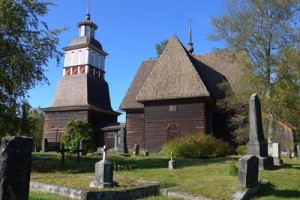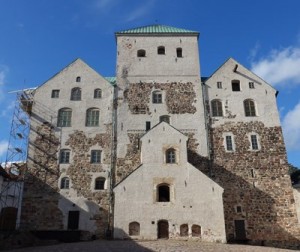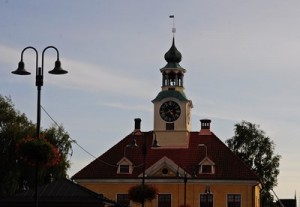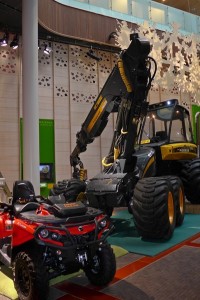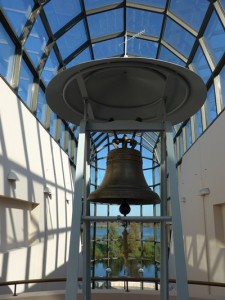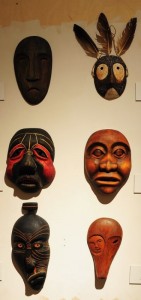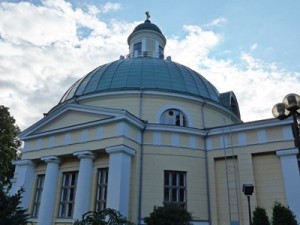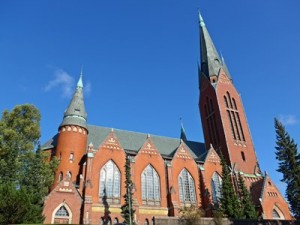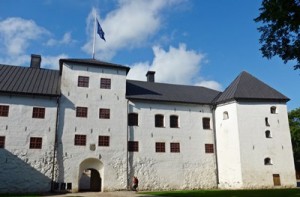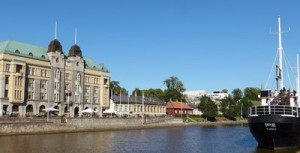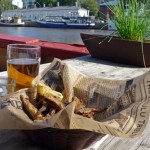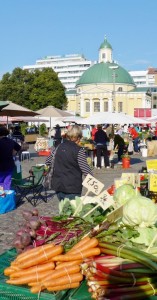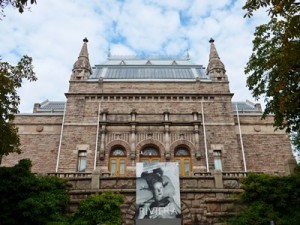6 Days in Helsinki, Rauma, Petäjävesi, Oulu, Rovaniemi & Turku
Finland is part of the geographic region of Fennoscandia which includes Scandinavia and parts of Russia. Buffered between Sweden and Russia, it was part of Sweden from the late 12th century and was occupied twice during the wars between Russia and Sweden (1714 – 1721 and 1742 – 1743). On March 29, 1809, it was incorporated into the Russian Empire as the autonomous Grand Duchy of Finland. During the Russian era, the Finnish language began to gain recognition and further fueled the demand for independence.
![map-of-finland[1]](http://www.sarahontheroad.hk/wp-content/uploads/2015/09/map-of-finland1-286x300.gif) The Russian Revolution of 1917 prompted the Finns to declare independence on December 6, 1917. The new nation was immediately embroiled in a civil war and finally became a presidential republic in 1919. Finnish forces fought in three separate conflicts during the World War II: the Winter War (1939-40) and Continuation War (1941-1944) against the Soviet Union, and the Lapland War (1944-1945) against Nazi Germany. Finland joined the United Nations in 1955 and established an official policy of neutrality. It joined the European Union (EU) in 1995 and the Euro zone at its inception in 1999.
The Russian Revolution of 1917 prompted the Finns to declare independence on December 6, 1917. The new nation was immediately embroiled in a civil war and finally became a presidential republic in 1919. Finnish forces fought in three separate conflicts during the World War II: the Winter War (1939-40) and Continuation War (1941-1944) against the Soviet Union, and the Lapland War (1944-1945) against Nazi Germany. Finland joined the United Nations in 1955 and established an official policy of neutrality. It joined the European Union (EU) in 1995 and the Euro zone at its inception in 1999.
Known as a country of thousands of lakes and islands (about 188,000 lakes and 179,000 islands), Finland has an area of 338,224 km² of which 25% lies within the Arctic Circle. It boasts six cultural and one natural World Heritage Sites namely Old Rauma, Fortress of Suomenlinna, Petäjävesi Old Church, Bronze Age Burial Site of Sammallahdenmäki, Verla Groundwood and Board Mill, the Kvarken Archipelago and Struve Geodetic Arc.
Finland has a small population (5.484 million in 2015) and is the most sparsely populated in the EU. It has made remarkable economic progress since its independence. It has transformed from a largely agrarian country into an advanced economy with an extensive Nordic-style welfare state in the past five decades. It enjoys a high standard of living with a GDP(PPP) and per capita of $224.846 billion and $40,838 respectively (2015 estimate). It is a top performer in numerous metrics of national performance, including education, economic competitiveness, civil liberties, quality of life and human development. Finland ranked first in the World Human Capital index in May 2015.
September 8 Tuesday: Copenhagen, Denmark (GMT+1) – Helsinki, Finland (GMT+2)
My flight took off from Copenhagen around 1:30 pm. I landed in Helsinki airport around 4 pm. Helsinki has good public transport system. I bought a return bus ticket to the city centre for €11.50 and then took Tram 10 (€3 for unlimited ride for an hour). I arrived at Annikki’s doorstep before 6 pm!
I first met Annikki through work in Helsinki seven years ago. After working in Hong Kong for a few years, she retired last year and now lives in Helsinki. She has kindly welcomed me to stay with her and her cat. So I had a cozy home stay!
Annikki is philosophical, a Sinologist and thinker. Walls in her flat are covered with books including many Chinese classics. Mushrooms are in season. She made me a most delicious mushroom pie. I had apple pie for dessert with apples from her city garden.
I told Annikki of my plan to visit some of these World Heritage Sites. After spending over an hour surfing the internet, I came to the conclusion that a 7-day bus pass at a cost of €149 would enable me to travel all over the country in search of these sites and see Finland in a most economical way. I had a sofa bed and had a good sleep.
September 9 Wednesday: Helsinki – Rauma
I got up after 8 am. It’s a blessing to have home baked cinnamon rolls for breakfast. I took two with me as well. At 10am, I left for the bus station and finally brought a 7-day bus pass. By 11 am, I was on the bus heading to Rauma, about 215 km on a straight line from Helsinki. As I had to change bus once, I did not arrive at my destination till 3 pm. I spent a while to look for the hotel which is about 2 km from the bus station. It was almost 4 pm when I put down my backpack in the hotel.
I headed back to Old Rauma, one of the oldest harbours in Finland situated on the Gulf of Botnia. Built around a Franciscan monastery, where the mid-15th-century Holy Cross Church still stands, it is an outstanding example of an old Nordic city constructed in wood. Although ravaged by fire in the late 17th century, it has preserved its ancient vernacular architectural heritage. Old Rauma is a typical Scandinavian wooden town forming a unified area of historical, single-storey buildings, a partly medieval street network and a viable urban community complete with dwellings, shops and services.
The town looked sleepy with only a few shops open for business. Some are selling antique stuff. I had no interest in the shops or the local museums. The only place I had visited was the Holy Cross Church. Apparently, many people were staying indoor to watch an important basket ball match.
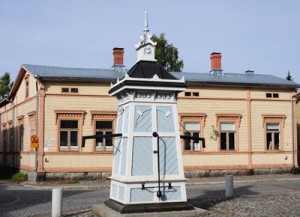 |
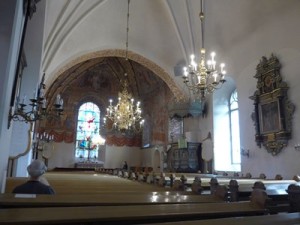 |
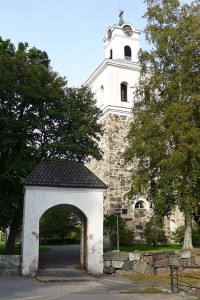 |
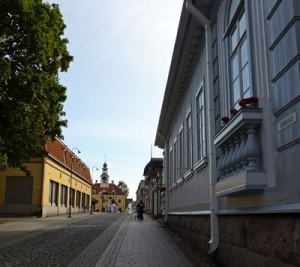 |
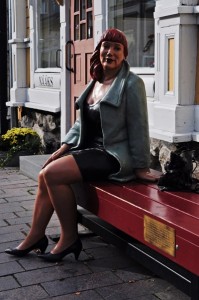 |
I was tired and ready for an early dinner. I found a Nepalese restaurant and had the menu of the day – butter chicken – for €12.50. Not bad! I walked leisurely along the canal at the end of which is my hotel. The whole place is very quiet. The good thing for me is a sound and sweet sleep in dead silence!
September 10 Thursday: Rauma – Jyväskylä – Oulu
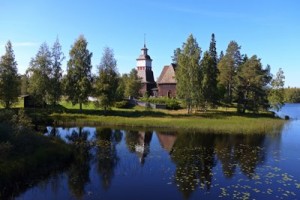 My original plan was to visit the Bronze Age Burial Site at Sammallahdenmäki located in the Lappi parish in Lower Satakunta about 15 km from Rauma. This archaeological site featuring more than 30 granite burial cairns is an exceptionally valuable monument from the Bronze Age providing a unique insight into the funerary practices and social and religious structures of northern Europe more than 3000 years ago. But without a car, it is difficult and very time consuming to reach this site (I had to take a bus to Lappi at 6:50 pm and then walk 5 km or take a taxi). I decided to go straight to the Petäjävesi Old Church in central Finland.
My original plan was to visit the Bronze Age Burial Site at Sammallahdenmäki located in the Lappi parish in Lower Satakunta about 15 km from Rauma. This archaeological site featuring more than 30 granite burial cairns is an exceptionally valuable monument from the Bronze Age providing a unique insight into the funerary practices and social and religious structures of northern Europe more than 3000 years ago. But without a car, it is difficult and very time consuming to reach this site (I had to take a bus to Lappi at 6:50 pm and then walk 5 km or take a taxi). I decided to go straight to the Petäjävesi Old Church in central Finland.
I took the 6:50 am bus to Jyväskylä and then another local bus to Petäjävesi. By the time I reached Petäjävesi, it was 2 pm. The church is one kilometre from the village. Fortunately I was able to reach it in time before it closed at 3 pm.
This Lutheran country church built of logs under the direction of master builder Jaakko Klemetinpoika Leppänen, is a typical as well as excellent example of an architectural tradition that is unique to eastern Scandinavia. The floors, walls and steep shingle roof were finished during the summer of 1763 and the interior in 1764 while the windows were installed in 1765. The bell tower dates from 1821. It combines the Renaissance conception of a centrally planned church with older forms deriving from Gothic groin vaults. It has survived in its original form extremely well: the timber walls and floors are not painted.
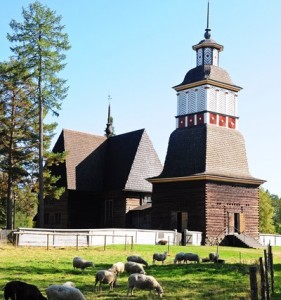 |
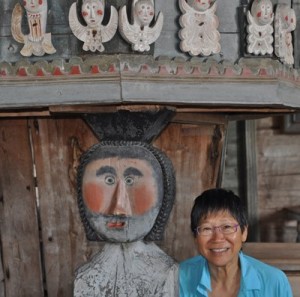 |
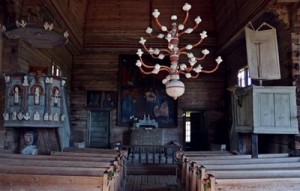 |
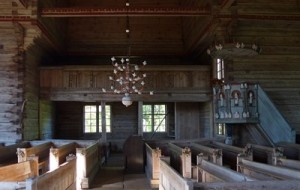 |
I fall in love with this toy-like church which is unique, rustic but most charming and in excellent condition. The pulpit is decorated with four evangelists, Jesus and a number of angels. It is carried by the patron saint of travellers Saint Christopher, the carrier of Christ, with red cheeks and thick eyebrows. Opposite of the pulpit is the stand of the cantor from where the cantor led the hymn singing. The stick behind the stand was used to wake up people who had fallen asleep during the service! Outside the church is a cemetery, the resting places of some 9,100 local people.
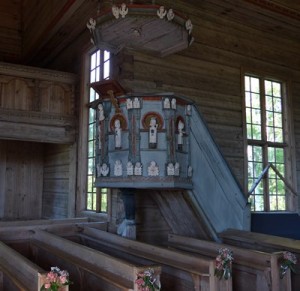 |
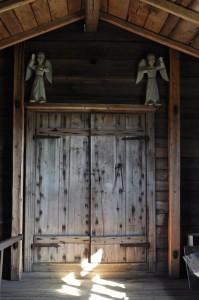 |
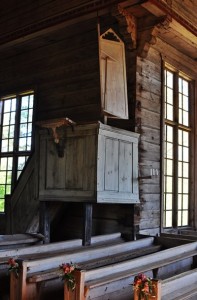 |
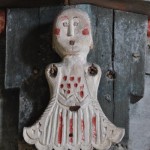 |
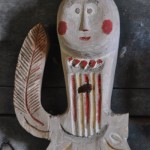 |
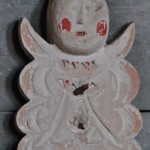 |
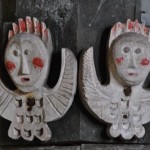 |
I took the 4 pm bus back to Jyväskylä and then the 5 pm bus to Oulu, I arrived at Oulu at 10 pm. On the way, I could see vivid green and purple lights behind trees: these are Northern Lights! It was dark and there was few people in the street. I had no map in hand and had a difficult time in finding the place where I was supposed to stay. The problem was that I had to go to the hotel address to pick up a key and walk a few more blocks to open a studio flat with the key. Well the flat is spacious and nice but I prefer to stay in a proper hotel!!
September 11 Friday: Oulu – Rovaniemi
I must be tired and did not wake up till 9 am. I had a few hours to explore Oulu before taking a bus to Rovaniemi at 3:15 pm.
Oulu with a population of about 200,000, is the most populous city in Northern Finland and the 5th populous city in Finland. It is also considered one of Europe’s “living lab” where residents experiment with new technology at community-wide scale.
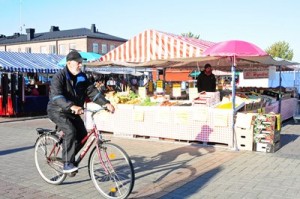 |
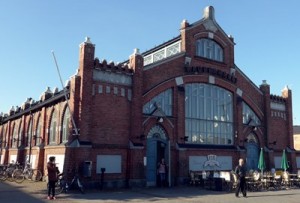 |
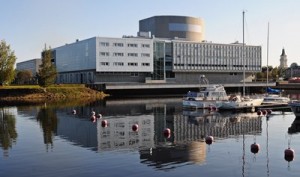 |
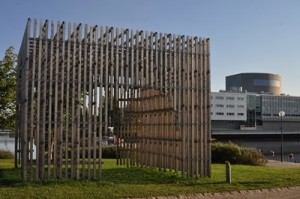 |
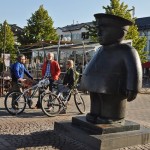 The city centre is small with a nice pedestrian streets and a lively harbour. A new cultural centre, an open air market, a nice old Market Hall and many old wooden houses are all located around the harbour. There are many eateries and souvenir shops. I brought a piece of salmon from the market and returned to the flat to cook it. I had a nice light lunch before leaving the flat shortly after midday.
The city centre is small with a nice pedestrian streets and a lively harbour. A new cultural centre, an open air market, a nice old Market Hall and many old wooden houses are all located around the harbour. There are many eateries and souvenir shops. I brought a piece of salmon from the market and returned to the flat to cook it. I had a nice light lunch before leaving the flat shortly after midday.
I had two hours wandering around the city. The colourful City Hall and Cathedral (which was closed) and the Mannerheim Park are the main attractions. I find the city green with a relaxing atmosphere!
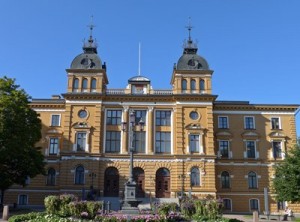 |
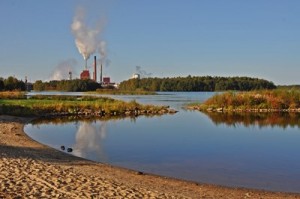 |
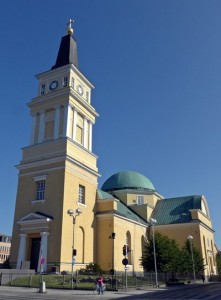 |
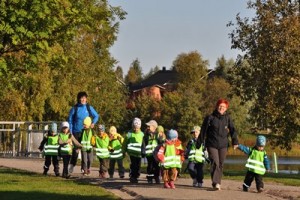 |
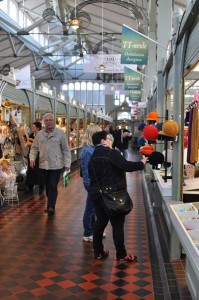 |
The bus ride to Rovaniemi took about three hours. As it was still bright, I had no problem in finding the City Hotel near the river.
Rovaniemi situated about 10km south of the Arctic Circle, is the capital of the Province of Lapland. It is the official home of Santa Claus and a popular place for watching Northern Lights, the display of which can be as high as 200 a year.
I saw Northern Lights in Yellowknife, Canada in 2012 and 2014 and recently in Greenland. On arrival, I asked the receptionist of City Hotel whether there were Northern Lights display the night before. She said there was a beautiful display with many people watching by the riverside. She suggested me go out around 11pm. I did but there was no sign. When I was back in the hotel half an hour later, the receptionist on night duty said she had not seen any on her way to the hotel and the chance for having the lights was slim. So I went to my room to write my travel notes till 2 am. (The next day, the receptionist on day duty said she saw Northern Lights display late in the night).
September 12 Saturday: Rovaniemi – Turku
I got up at 9am and had an excellent buffet breakfast. It was the main meal of the day. I checked out, left my backpack in the hotel and had a leisure day. Rovaniemi’s main landmarks are the Jätkänkynttilä bridge, the Arktikum House comprising the Town Hall, the Lappia House and the library, the Santa Claus village, Santa Park.
I brought a combo ticket for three museums for €20. Pike Science Centre (next to Arktikum) has a temporary exhibition on trees and forests in Finland, their value and importance, how to conserve and manage the resources.
Arktikum (Arctic Museum) is a very comprehensive museum of Finland’s and the world’s Arctic regions. A temporary exhibition We Were Friends – Finnish – German Encounters in Lapland 1940-1944 gives me an idea of the complex relationship with Germany during the World War II. The two videos/films on Northern Lights displays are vivid and life-like.
Rovaniemi Art Museum has several amazing temporary exhibitions. A retrospective exhibition Carried by Lightshows Marja Pirilä’s photos taken over three decades. I find her photos using the methods of camera obscura and pinhole camera fascinating and beautiful. Another exhibition entitled New and Newest shows impressive contemporary art under three themes- colour, organic and people.
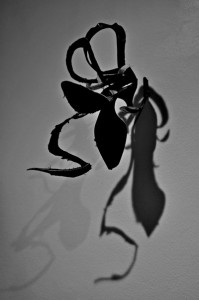 |
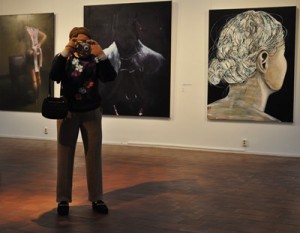 |
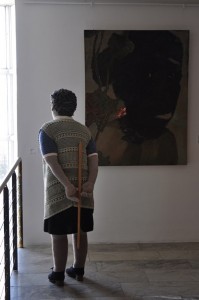 |
The third exhibition Dancing Fur Boots- Stories from Lapland by Andreas Alariesto (1900-1989) is enchanting. Alariesto’s delightful and colourful paintings portray the traditional everyday life of ordinary people. The fourth exhibition Kursk and Melancholy is impressive. Markus Copper tells the tragic destiny of the submarine Kursk which sank killing all 118 sailors on August 12, 2000. Of these 118 sailors, 23 had survived the initial explosions for more than six hours. Cooper’s installation using sound, several black figures struggling in dark behind the steel door evoke strong feelings. I can feel the pain, fear and desperation of the 23 sailors during the last six hours in their life.
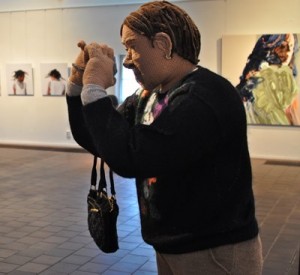 |
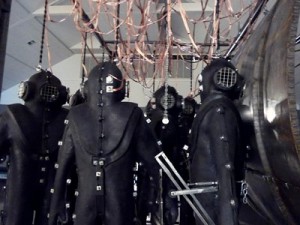 |
I planned to spend my last night in Finland in Turku, the old capital of Finland. So I took the 5:15pm overnight bus to Helsinki (13 hours) where I could take another bus to Turku (around two and a half hours). The driver told me to get off in Lahti where there is a connecting bus to Turku. In this way, I saved at least four hours and arrived in Turku at 7:30 am. A night bus saves time but is uncomfortable, to say the least. I can’t sleep and unlikely take another night bus again.
September 13 Sunday: Turku
Turku located on the southwest coast of Finland at the mouth of Aura River, is the oldest city in Finland (likely to have been founded at the end of the 13th century). After Finland became part of the Russian Empire in 1809, the capital of the Grand Duchy of Finland was moved from Turku to Helsinki in 1812. Nonetheless, Turku remains a regional capital and an important and cultural centre. With a population of over 300,000, the Turku sub-region is the third largest urban area after Greater Helsinki and Tampere. Turku is the official Christmas city of Finland, and ‘Christmas Peace’ in Finland is declared on every 24th December from the Brinkkala Hall balcony. Given its rich history and culture, it is European Capital of Culture in 2011.
I arrived in Turku and found my hotel right next to bus station before 8 am. As I could not check in till 2pm, I walked to the town centre after leaving my backpack with the receptionist. After ten minutes’ walk, I arrived at the Market Square next to it is an Orthodox Church. The city was quiet and the only places I found people at this time of the day were the churches. I first went to the Orthodox Church (or the Church of the Holy Martyr Empress Alexandra) built between 1839 and 1845 at a cost of 67,886 rubles. Then I reached the Michael’s Church built about a century ago. The church was full and I stayed for a while listening to the music.
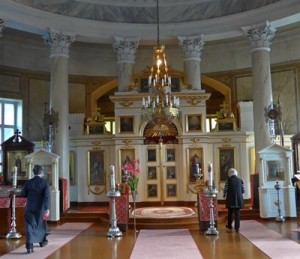 |
|
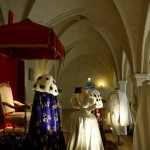 I strolled leisurely along the shady streets and finally arrived at the Turku Castle which together with Turku Cathedral, is one of the oldest buildings still in use in Finland. Founded in the late 13th century and standing on the banks of the Aura River, it is a must-see attraction. Served as a defensive bastion, a majestic court, an administrative centre, a prison, a storehouse and a barrack, the castle which once housed as many as 600 people is interesting. I followed a well-designed route that takes me to see various chamber, chapels, halls etc with good illustrations which tell the story of the castle, Turku and Finland. I was tired at the end of the visit.
I strolled leisurely along the shady streets and finally arrived at the Turku Castle which together with Turku Cathedral, is one of the oldest buildings still in use in Finland. Founded in the late 13th century and standing on the banks of the Aura River, it is a must-see attraction. Served as a defensive bastion, a majestic court, an administrative centre, a prison, a storehouse and a barrack, the castle which once housed as many as 600 people is interesting. I followed a well-designed route that takes me to see various chamber, chapels, halls etc with good illustrations which tell the story of the castle, Turku and Finland. I was tired at the end of the visit.
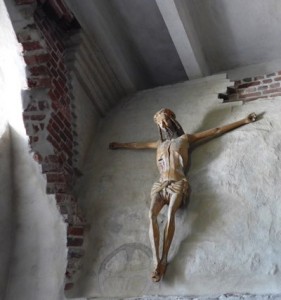 |
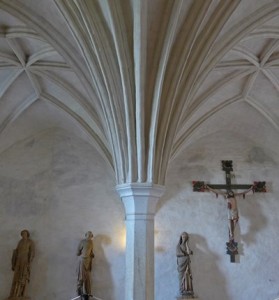 |
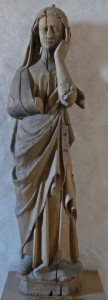 |
I walked along the Aura River and had a lovely late lunch in one of the boat cafes. I had 500g of fried local fish and a beer. What a wonderful way to soak in the atmosphere and enjoy a Sunday brunch!
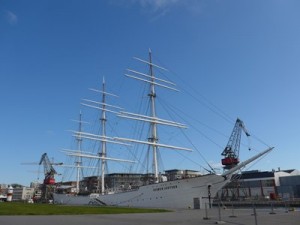 |
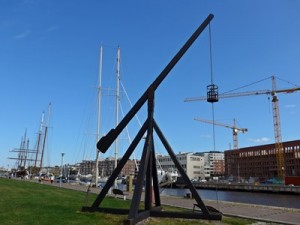 |
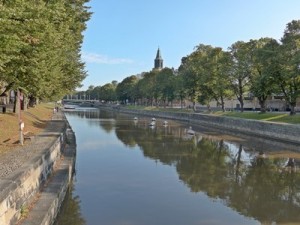 |
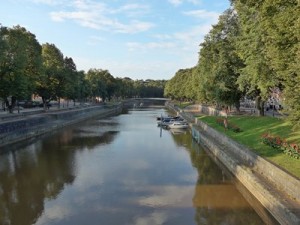 |
After crossing the river, I arrived at Turku Cathedral at the Old Great Square. But I went to the Sibelius Museum first because it would be closing at 4 pm. The receptionist allowed me in and charged me a student fee for €I (instead of €3) for a 10-minute tour! Jean Sibelius (1865-1957) was a violinist and composer of the late Romantic and early-modern periods. He is widely recognised as Finland’s national composer supporting the rise of Finnish national identity in the country’s struggle for independence.
I wanted to visit the Turku Art Museum which would close at 5 pm. But I had to walk 10 minutes to get there. Exhausted after a sleepless night, I decided to give it a miss.Instead, I went to Turku Cathedral near the Sibelius Museum. Parts of the cathedral were closed as a choir was rehearsing for a concert at 7:30 pm.
I returned to the hotel, took a nap before going back to the Cathedral for the concert. The Cathedral was lit up and atmospheric. The concert lasted for an hour with ten performances. I walked back to the hotel totally exhausted and slept like a log.
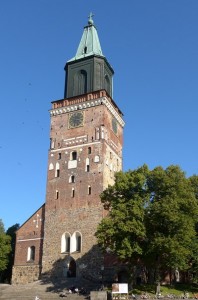 |
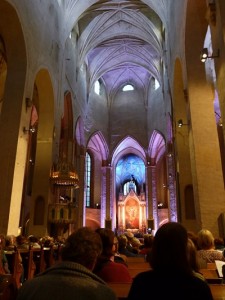 |
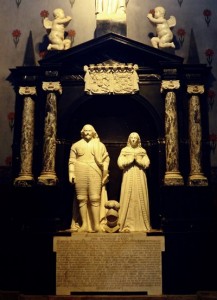 |
September 14 Monday: Turku – Helsinki – Hong Kong
I got up after 8 am, packed and left my stuff in the room. I spent the next three hours exploring the city on foot again. First I returned to Turku Cathedral, the mother church of the Luthern Church of Finland and the country’s national shrine. It was consecrated as the Cathedral Church of the Blessed Virgin and St Henry (the first Bishop of Finland) in 1300.
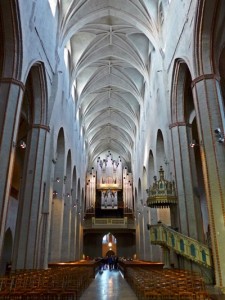 |
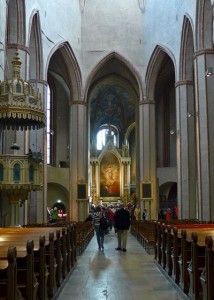 |
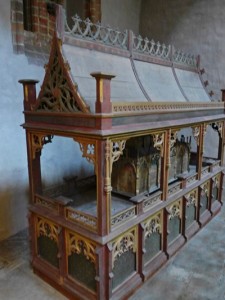 |
Then I went to area close by to see old wooden houses before crossing the river to return to the Market Square. This time, I found many market stalls selling vegetable, fish, fruits, plants etc. I brought a pair of comfortable walking shoes made in Finland.
The bus took two and a half hours to return to Helsinki. I made my way back to Annikki’s place. She could not believe how far I had travelled in the past six days with the bus pass. Annikki was very kind and made sure I had a full stomach before taking my 11:40 pm flight to Hong Kong.
I left her home early in order to buy reindeer meat at the duty free shops before they closed at 9 pm. Unfortunately, they were closed when I got there. The plane departed on time and I was back in Hong Kong around 2:30 pm the following day. I did not sleep much and was tired. But as soon as I enter my sweet home, I feel energetic and happy!


